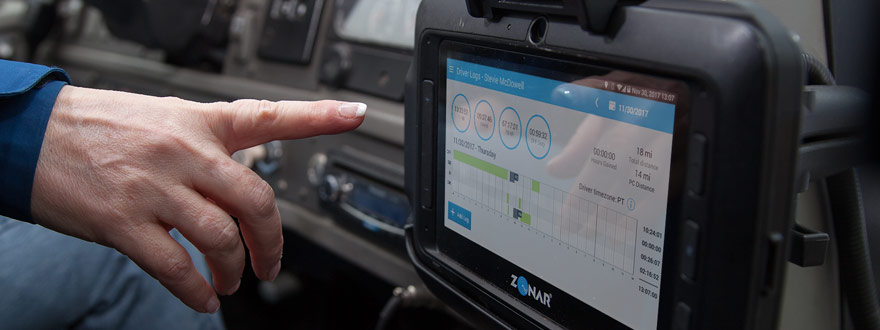Electronic Logging Devices (ELDs) are required for most commercial motor vehicles in North America. But what about those who don’t need an ELD? Are there any ELD Mandate exemptions? Who is exempt from the ELD rule and why?
In this article, we delve into these questions and more, providing a comprehensive overview of ELD regulations and exemptions.
What is an Electronic Logging Device (ELD)?
An ELD is a device that electronically records a truck driver’s hours of service (HOS). This helps fleet managers and drivers stay compliant with the Federal Motor Carrier Safety Administration (FMCSA) regulations that limit how long a driver can operate without taking a break.
The FMCSA requires all commercial motor vehicles to be equipped with an ELD, unless they meet certain exemptions.
Who does the ELD Rule impact?
The rule applies to most interstate truck drivers operating in the U.S., as well as their employers. This includes commercial trucks over 10,000 lbs, vehicles designed or used to transport 16 or more passengers (including the driver), and vehicles transporting hazardous materials that require placards. The rule does not apply to drivers operating solely in intrastate commerce. (In Canada, the ELD Mandate was developed and released through Transport Canada.)
Who is exempt from the ELD rule?
There are a few categories of drivers who are exempt from having an ELD in their vehicle, including:
- Vehicles Manufactured Before 2000: These vehicles do not have an engine control module that can support electronic logging devices, so they are exempt from the mandate.
- Driveaway-towaway Drivers: Drivers who are transporting vehicles under their own power, such as car haulers and tow truck operators, are exempt from having an ELD.
- Drivers Who Keep RODS for 8 Days or Less: If a driver keeps Record of Duty Status (RODS) for 8 days or less per month, then they do not need an ELD.
- Exceptions for Short-Distance Hauls: Drivers who complete trips within 150 air miles from their normal work reporting location may be exempt from using an ELD if they return to their starting point at the end of each day’s work shift. This exception also applies to agricultural operations within a 100 air mile radius and only during harvest season as determined by state law or regulation.
What Trucks Are ELD Exempt?
Certain types of trucks are exempt from needing an ELD due to their nature of operations or type of cargo being hauled. Examples include emergency vehicles such as fire trucks and ambulances; military trucks; recreational vehicles; mobile medical units; and tankers carrying gasoline, oil, propane gas etc., if they have been inspected according to federal regulations within 30 days before driving on public roads/highways. A full list of exemptions can be found here.
Is it necessary to keep paper logs if I am exempt?
Yes! All drivers must still maintain written logs while operating in accordance with FMCSA regulations, even if they are exempted from using an ELD device. A paper log book provides proof that you have complied with FMCSA rules when you were unable to use your device for whatever reason (e.g., technical issues). It also serves as evidence should you ever get pulled over by law enforcement officers and asked for your logbook information or proof that you haven’t violated any laws by driving beyond your limits without taking breaks .
ELD FAQs
Q: What is the purpose of the ELD mandate?
A: The ELD mandate was created in an effort to reduce paperwork and improve safety standards by eliminating paper logbooks. Specifically, it requires most truck drivers to use ELDs while on the road, ensuring they are not exceeding federal hours-of-service limits for their workday. It also requires ELDs to be connected to the vehicle’s engine, so that drivers cannot add, remove or modify data while driving.
The mandate also provides enforcement agencies with access to records in order to better monitor compliance with federal guidelines. This is intended to improve safety and reduce accidents due to driver fatigue.
Additionally, ELDs provide benefits to fleets including increased efficiency and improved safety record-keeping. It is important to note that all ELDs must be registered with the FMCSA, and must meet certain technical specifications.
Q: What fleets are affected by the ELD mandate?
A: The federal ELD mandate applies to most commercial vehicles operating in interstate commerce, meaning those crossing state lines and weighing more than 10,000 lbs. This includes both private fleets and for-hire carriers.
Vehicles operated by drivers who are exempt from the hours-of-service requirements or those in certain agricultural operations may be exempt. Additionally, many states have their own versions of the ELD mandate which apply to intrastate commerce as well.
Q: Are there any penalties for not complying with the ELD mandate?
A: Yes, it is important to note that failing to comply with the ELD mandate can result in significant fines and other penalties. Drivers may be issued out-of-service orders, or fleets may have their operating authority revoked.
In addition, carriers who violate the mandate may face civil penalties up to $10,000. It is important to remain in compliance with the ELD mandate in order to avoid these consequences.
Q: What should fleets do if they need help transitioning to ELDs?
A: Fortunately, there are many resources available to fleets who need help transitioning to ELDs and complying with the mandate. Fleet management software companies like ZenduiT offer comprehensive solutions that are tailored to meet the needs of different fleets.
Additionally, fleets can find helpful resources on the FMCSA website or contact their local state enforcement agency for assistance.
Q: What is the best way to ensure compliance with the ELD mandate?
A: The best way for fleets to ensure that they are in full compliance is to work closely with an experienced fleet management software provider. Fleet managers should also review their policies and procedures to make sure that they meet all of the requirements outlined by the FMCSA.
Lastly, fleets should take steps to ensure that drivers are properly trained and understand the regulations surrounding the use of ELDs. Following these guidelines will help keep fleets compliant and maximize their operational efficiency.
For additional information on the ELD mandate, read our Beginner’s Guide to Electronic Logging Devices (ELDs).
Conclusion
While the ELD Mandate has caused some controversy since it was first put into effect, it’s important to know whether or not your vehicle needs an ELD device.
If you’re still uncertain about whether or not your vehicle needs an ELD or have questions about the mandate in general, don’t hesitate to reach out to us. Our team would be more than happy to answer any questions you may have and help get you set up with a compliant solution.
Call us to schedule a demonstration with us today!








